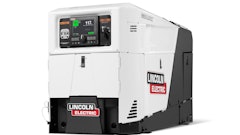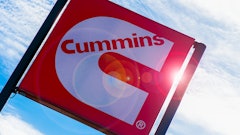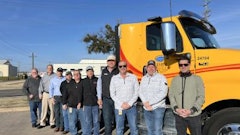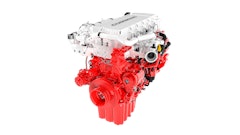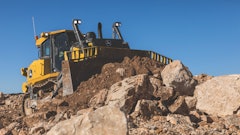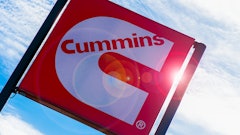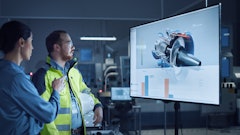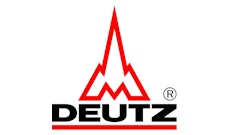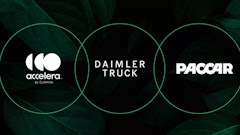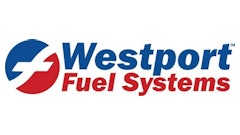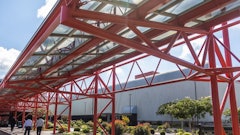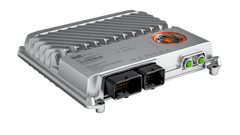
Started in 2010, the U.S. Department of Energy’s (DOE) SuperTruck program is challenging four teams from the heavy-duty Class 8 trucking industry to develop a truck which demonstrates a 50% improvement in overall freight efficiency compared to 2009 truck models.
With the project’s deadline just a year away, the teams participating in the program are close to delivering a finished product. Each team—composed of engine manufacturers and truck OEMs as well as various component suppliers—is tasked with improving efficiency 30% on the tractor and trailer, and 20% on the engine to achieve the overall 50% freight efficiency, which is measured in ton-miles per gallon. In addition, the vehicle’s engine needs to demonstrate 50% brake thermal efficiency and a path towards 55% brake thermal efficiency.
Cummins Inc. (company information, 10055252), Columbus, IN; Daimler Trucks North America LLC. (DTNA, company information, 10247983), Portland, OR; and Navistar Intl. Corp. (company information, 10055615), Warrenville, IL, each received cost-shared awards from the DOE in 2010 to participate in the program, and Volvo Group (company information, 10240575), Gothenburg, Sweden, joined in 2011. The Cummins, DTNA and Navistar teams have a 2015 deadline to produce their SuperTruck designs while the Volvo team’s final demonstration vehicle is due in 2016.
Cummins
Cummins and its lead partner in the SuperTruck program Peterbilt Motors Co. (company information, 10752762), Denton, TX, announced in March 2013 that real-world testing of its demonstration truck for the program achieved a 54% increase in fuel economy (read more, 11178476). A Class 8 Peterbilt 587, with a gross weight of 65,000 pounds, was used as the demonstration truck and was powered by a Cummins ISX15 engine (product information, 10247649). According to David Koeberlein, SuperTruck Principle Investigator at Cummins Inc., the truck did over 11 test runs consisting of a 312-mile route and averaged 9.9 mpg during testing.
“Long-haul trucks typically achieve between 5.5 and 6.5 mpg,” explains Koeberlein. Based on current diesel prices, the 54% improvement demonstrated by the Cummins and Peterbilt truck would equate to a yearly fuel savings of $25,000 for a long-haul truck traveling 120,000 miles per year, as well as a 35% reduction in annual greenhouse gases (GHG).
Along with the fuel economy improvements, Koeberlein says the truck also exhibited a 61% improvement in freight efficiency during testing compared to a baseline truck driving the exact same route. In the fourth quarter of 2013 Cummins and Peterbilt began testing a second demonstration vehicle with the goal of delivering a 68% freight efficiency improvement during a 24-hour cycle, which will include drive as well as hotel load cycles.
Three main groups of revisions were made to the prototype SuperTruck engine, says Koeberlein. The first group consisted of improvements to the combustion system. “Piston changes were matched with cylinder head port, EGR loop and turbocharger efficiency improvements, all of which were wrapped within a calibration and control system optimization,” he explains.
The second group of revisions focused on parasitic power and friction reductions for improved fuel efficiency, particularly when the truck is operating at lower speeds. “Changes that reduce parasitic power and mechanical friction contribute to fuel consumption improvement at all speeds and loads,” says Koeberlein, “but more importantly at low power levels where they become a larger percentage of the overall fueled power demand.” To reduce parasitic power, Cummins re-sized the coolant pump flow rate of the engine’s cooling system and employed a variable flow lube pump which adjusts flow output to match the amount needed to maintain oil rifle pressure. Unlike a typical fixed displacement lube pump—which matches oil pressure at a certain engine speed and creates often wasted excess flow above that speed—a variable flow pump does not waste excess flow, reducing the pump’s power requirements.
Cummins was able to reduce the coolant pump flow rate through the integration of a waste heat recovery (WHR) system. While typically the engine EGR cooler uses coolant, Koeberlein says the WHR system’s refrigerant provides the cooling capabilities instead. “This reduces the coolant flow requirement and enables the use of a reduced flow capacity pump, which reduces parasitic power,” he explains.
Koeberlein says Cummins has been working on the WHR system being used in the SuperTruck design for over seven years. He explains that the system is similar to how a steam power plant operates, except it’s a closed system which uses a recirculating low GWP (global warming potential) refrigerant. Waste heat is transferred to the refrigerant from the EGR cooler and exhaust boiler, causing the refrigerant to become heated and pressurized. It expands across a small turbine to create shaft power, which is transferred mechanically via a belt to the engine’s crankshaft. The cycle is completed when latent heat coming off the turbine first passes through a recuperating heat exchanger, then through a condenser, enabling the liquid refrigerant to enter the pump and control valve body before the heat collection cycle starts over. “The added turbine shaft power generated by the waste exhaust energy reduces fueled engine shaft power, improving fuel economy,” says Koeberlein.
Additional changes Cummins made to the engine include revisions in controls of the aftertreatment system, as well as the formulation of the SCR catalyst. Koberlien says the company also chose to integrate the WHR exhaust boiler heat exchanger in the outlet of the SCR catalyst. Connecting the exhaust boiler to the SCR catalyst limited heat losses, and reduced part count and overall package length.
Apart from the many engine advancements Cummins is making, Peterbilt is contributing to the project through advancements on the tractor and trailer of the SuperTruck design. Peterbilt is incorporating electronic controls on the truck which will use driver route information, GPS location and engine efficiency information to alter the truck’s cruising speed to a rate that will ensure optimal fuel economy.
Daimler
In early 2013, DTNA completed development and testing of the individual technologies that will be used on its final SuperTruck design. Derek Rotz, Senior Manager, Advanced Engineering NAFTA at Daimler Trucks North America LLC., says the company is now in the build phase of the project, integrating the various technologies it will use into one vehicle. “The project is on track to begin testing the middle of next year and we will complete the 50% improvement in freight efficiency test by the second half of 2014,” he explains.
Improving the aerodynamics of the vehicle—both the tractor and the trailer—were a key factor in achieving the overall freight efficiency goals of the program. “Daimler used the opportunity within the SuperTruck program to take a different approach to aerodynamics design,” says Rotz. He explains that the company started with a clean sheet by first conducting basic shape analysis with the goal of defining an optimal aerodynamic design that would not be limited by conventional design constraints. “We later evolved the idealized shape into a workable truck design, while carefully managing design tradeoffs to minimize aerodynamic drag impacts,” says Rotz.
Examining airflow on both the tractor and trailer enabled DTNA to view the two parts as a complete system. Rotz says the company was given the rare opportunity to study trailer design such as optimizing the geometries for the boat tail and side skirt. In addition, DTNA was able to evaluate the effects of the gap between the tractor and trailer to find a solution that would minimize any negative impacts to the efficiency of the truck. “We observed that aerodynamic enhancements made on the tractor affect the trailer downstream, and that an optimum design must take both into account,” he says.
When DTNA began working on its SuperTruck design, it was considering the use of either a solid oxide fuel cell or a hybrid electric powertrain to minimize idling. According to Rotz, the company has chosen to go with an anti-idle solution based on the hybrid electric powertrain as it exceeds DTNA’s efficiency target, as well as provides a lower weight solution. For both on-highway and parked mode operations, a single air conditioning system will be used to provide cooling to the operator cab while the engine is off. The refrigerant circuit has been redesigned to include a high voltage electric compressor and a remote mounted condenser with an electric fan, while a lithium-ion battery provides power to the entire system.
Engine improvements
On the engine side of things, DTNA has developed a number of features to help reduce parasitic losses for improved efficiency. These include optimizing engine accessories, designing components with inherently lower friction, altering lubrication oil properties and reducing over-the-road engine speed.
Utilizing the right type of controls on the engine will play a large part in ensuring its efficiency. Kevin Sisken, Manager, Technology Programs and Benchmarking at Daimler Trucks North America LLC., says the typical approaches used for powertrain control can be classified as table based or model based, which is the method DTNA is using for its SuperTruck engine. The table-based approach tend to be as simple as comparing a look-up table for a given control parameter to engine speed and load. Model-based controls, on the other hand—which include predictive control techniques—use a well constructed/calibrated model to calculate powertrain control parameters. “The potential advantages of model-based methods include operation of the powertrain in a near optimized condition regardless of the environmental conditions or duty cycle demands,” says Sisken.
“Future engine controls will feature an increasing mix of model-based/predictive controls amidst conventional look-up tables,” he adds. “A very ‘smart’ and integrated powertrain/vehicle system will yield benefits for the customer and the environment.”
A WHR system will be included, as well, and is expected to improve engine brake thermal efficiency by 2% or more, which Sisken explains is equivalent to a 4% or greater improvement in fuel economy, as measured in miles per gallon.
The system captures and utilizes thermal energy from the engine’s exhaust gas recirculation (EGR) cooler and the engine exhaust gas. Energy captured by the system is then converted into usable power via a Rankine heat engine. Working fluid within the Rankine heat engine is passed through two heat exchangers containing heat energy from the engine’s EGR and exhaust systems. This heat energy causes the working fluid to be converted from a liquid to a super-heated gas which is then passed through a scroll expander to cool the working fluid back into a liquid. The liquid working fluid next passes through a pump that directs the fluid to the heat exchangers to begin the Rankine cycle all over again. “While the system today is in early prototype form and many technical and cost challenges still must be addressed, the potential for fuel economy benefits is intriguing,” says Sisken.
“The SuperTruck program has been a continual learning experience for Daimler as numerous technologies and concepts were explored,” says Rotz. “We continue to generate new ideas for improving freight efficiency even though the SuperTruck design is complete and is currently being built. Research in this area is an ongoing process.”
Volvo
Joining the SuperTruck program in 2011, Pascal Amar, Senior Project Manager overseeing Volvo Group’s involvement in the SuperTruck program, says the company has already implemented a nearly 50% freight efficiency improvement on its SuperTruck design. “Despite the very efficient baseline truck we selected, with a freight efficiency around 115 ton-miles/gallon, we will have surpassed the program’s goal by the end of our project,” says Amar.
Volvo has already reduced aerodynamic drag 26% on its demonstration vehicle through the use of various trailer add-on devices and modified tractor fairings. Amar says the next level of design changes to the tractor will produce an overall drag reduction of 40%. The company is working to create freight efficiency solutions that can be used in the near-term without affecting operational effectiveness. “We are working together with Ridge Corp. [and] Freight Wing and use a combination of Computational Fluid Dynamics (CFD) and wind-tunnel testing to optimize the complete geometry of tractor and trailer add-on devices,” he explains. “Our goal is to increase the knowledge on what aerodynamic improvements can be achieved in commercial vehicles.
“It has become clear that better integration of the complete vehicle is critical to maximizing fuel savings from aerodynamic improvements, as the powertrain optimization needs to take into account the reduced aerodynamic forces,” adds Amar.
To help achieve the efficiency goals of the program, Volvo is currently evaluating several hybrid technology concepts for auxiliary power supply. Amar says each of the concepts being considered will utilize advancements in battery technology to integrate a compact and lightweight, high capacity on-board electrical energy storage system with an electrified hotel load package. In addition to being more efficient than idling the engine during rest periods, using a battery-powered APU (auxiliary power unit) running on either captured kinetic energy or electrical outlets will eliminate exhaust emissions.
Revisions to the engine
Like the Cummins and Daimler teams, a WHR system will be used on the final SuperTruck design. “This process results in increased overall thermal efficiency, yielding more horsepower for the same amount of fuel,” says Amar.
Originally launched in 2011, Volvo’s XE (eXceptional Efficiency) package has proven that downspeeding can improve efficiency without sacrificing vehicle performance. The XE package allows the engine to cruise at a lower rpm—about 200 rpm—than average trucks currently on the market through the use of the Volvo’s I-Shift automated manual transmission and a Volvo engine with modified software (learn more, 11197795). According to the company, fuel efficiency improves about 1.5% for every 100 rpm of downspeeding. Amar says a combination of engine design, transmission technology and embedded software will be used to advance the XE concept further to enable an even lower cruising RPM and higher efficiency without compromising drivability.
Reducing parasitic losses and driveline friction are also on the agenda for engine improvements. Amar says the company is evaluating various state-of-the-art lubricants, as well as materials and coatings to help reduce component friction. To lower parasitic losses, he says Volvo is developing advanced control strategies to more intelligently manage energy flow within the entire vehicle. “These strategies will reduce the overall amount of energy required to move a given payload from point A to point B, thus reducing fuel consumption and increasing freight efficiency,” explains Amar.
An Advanced Driver Assistance System will also be implemented on the final SuperTruck design. The goal of the system is to provide an intuitive solution that is integrated with the driver interface and vehicle management systems to keep drivers better informed so they can operate the vehicle in a more efficient manner. “Industry statistics show that a driver can affect freight efficiency by up to 30%, so there’s a significant opportunity for technology to help equalize that variance,” says Amar.
Amar concludes that Volvo is also evaluating emerging materials and design techniques to develop cost-effective components for the transportation industry which are more sustainable and lighter in weight.











